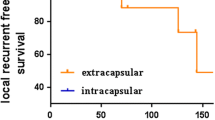Abstract
Background
Prophylactic surgery for patients carrying a positive RET proto-oncogene proved to be highly effective in curing those likely to experience the development of a medullary carcinoma. Video-assisted procedures have been proved feasible for central compartment dissection.
Methods
A total of 15 patients (7 men and 8 women) with a positive RET proto-oncogene underwent total thyroidectomy and central compartment lymphadenectomy via a video-assisted approach. The mean age of the patients was 32.5 years. The echographically estimated mean volume was 10.3 ml, and the mean diameter of the main nodule was 8.8 mm. Preoperative ultrasound showed an absence of lateral neck lymph node involvement in all cases. No drain was used. Direct laryngoscopy was performed in all cases 1 month after surgery.
Results
The mean operative time was 67.3 min. A transient hypoparathyroidism occurred in one patient, and a permanent hypoparathyroidism occurred in another patient. No laryngeal nerve palsy was present. All the patients were discharged on postoperative day 1. Histology showed a medullary carcinoma in 10 patients and diffuse C-cell hyperplasia in 5 patients. The mean number of lymph nodes removed was 5.1. None of these nodes proved to be metastatic. Calcitonin levels were undetectable in all six patients who had a follow-up period longer than 1 year.
Conclusion
Video-assisted central compartment lymphadenectomy was proved to be effective and safe. The procedure demonstrated a complication rate comparable with that for the conventional procedure, a better cosmetic outcome, and less postoperative pain. Although the video-assisted access proved to be a valid option for the treatment of patients carrying a positive RET proto-oncogene, a greater number of cases with a longer follow-up period is necessary to estimate the impact of the video-assisted approach on central neck lymphadenectomy.

Similar content being viewed by others
References
Bellantone R, Lombardi CP, Bossola M, Boscherini M, De Crea C, Alesina PF, Traini E (2002) Video-assisted vs conventional thyroid lobectomy: a randomized trial. Arch Surg 137: 301–304
Bellantone R, Lombardi CP, Raffaelli M, Boscherini M, Alesina PF, Princi P (2002) Central neck lymph node removal during minimally invasive video-assisted thyroidectomy for thyroid carcinoma: a feasible and safe procedure. J Laparoendosc Adv Surg Tech A 12: 181–185
Cheah WK, Arici C, Ituarte PH, Siperstein AE, Duh QY, Clark OH (2002) Complications of neck dissection for thyroid cancer. World J Surg 26: 1013–1016
Dralle H, Gimm O, Simon D, Frank-Raue K, Gortz G, Niederle B, Wahl RA, Kocm B, Walgenbach S, Hampel R, Ritter MM, Spelsberg F, Heiss A, Hinze R, Hoppner W (1998) Prophylactic thyroidectomy in 75 children and adolescents with hereditary medullary thyroid carcinoma: German and Austrian experience. World J Surg 22: 744–751
Duh QY (2003) Presidential address: minimally invasive endocrine surgery: standard of treatment or hype? Surgery 134: 849–857
Franc S, Piccoli-Sire P, Cohen R, Bardet S, Maes B, Murat A, Krivitzky A, Modigliani E (2001) Complete surgical lymph node resection does not prevent authentic recurrences of medullary thyroid carcinoma. Clin Endocrinol 55: 403–409
Frilling A, Dralle H, Eng C, Raue F, Broelsch CE (1995) Presymptomatic DNA screening in families with multiple endocrine neoplasia type 2 and familial medullary thyroid carcinoma. Surgery 118: 1099–1104
Ikeda Y, Takami H, Sasaki Y, Takayama J, Niimi M, Kan S (2002) Comparative studies of thyroidectomies: endoscopic surgery vs conventional open surgery. Surg Endosc 16: 1741–1745
Kitagawa W, Shimizu K, Akashu H, Tanaka S (2003) Endoscopic neck surgery with lymph node dissection for papillary carcinoma of the thyroid using a totally gasless anterior neck skin lifting method. J Am Coll Surg 196: 990–994
Lips CJM, Landsvater RM, Hoppener JWM, et al. (1994) Clinical screening is compared with DNA anlysis in families with multiple endocrine neoplasia type 2A. N Engl J Med 331: 828–835
Machens A, Schneyer U, Holzhausen HJ, Dralle H (2005) Prospects of remission in medullary thyroid carcinoma according to basal calcitonin level. J Clin Endocrinol Metab 904: 2029–2034
Meurisse M, Defechereux T, Maweja S, Degauque C, Vandelaer M, Hamoir E (2000) Evaluation of the Ultracision ultrasonic dissector in thyroid surgery: prospective randomized study. Ann Chir 125: 468–472
Miccoli P, Berti P, Raffaelli M, Materazzi G, Baldacci S, Rossi G (2001) Comparison betweem minimally invasive video-assisted thyroidectomy and conventional thyroidectomy: a prospective randomized study. Surgery 130(6): 1039–1043
Miccoli P, Elisei R, Berti P, Materazzi G, Agate L, Castagna MG, Cosci B, Faviana P, Ugolini C, Pinchera A (2004) Video-assisted prophylactic thyroidectomy and central compartment nodes clearance in two RET gene mutation adult carriers. J Endocrinol Invest 27: 557–561
Miccoli P, Materazzi G (2004) Minimally invasive video-assisted thyroidectomy (MIVAT). Surg Clin North Am 84: 735–741
Pacini F, Romei C, Miccoli P, Elisei R, Mocinaro E, Mancusi F, Iacconi P, Basolo F, Martino E, Pinchera A (1995) Early treatment of hereditary medullary thyroid carcinoma after attribution of multiple endocrine neoplas type 2 gene carrier status by screening for “RET” gene mutations. Surgery 118: 1031–1035
Wells SA, Chi DD, Toshima K, et al. (1994) Predictive DNA testing and prophylactic thyroidectomy in patients at risk for multiple endocrine neoplasia type 2A. Ann Surg 22: 237–250
Author information
Authors and Affiliations
Corresponding author
Rights and permissions
About this article
Cite this article
Miccoli, P., Elisei, R., Donatini, G. et al. Video-assisted central compartment lymphadenectomy in a patient with a positive RET oncogene: initial experience. Surg Endosc 21, 120–123 (2007). https://doi.org/10.1007/s00464-005-0642-3
Received:
Accepted:
Published:
Issue Date:
DOI: https://doi.org/10.1007/s00464-005-0642-3




